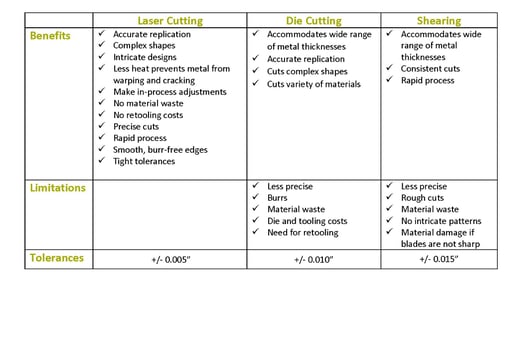Use this metal-cutting comparison chart to guide your manufacturing decisions
by JC Kocjancic, on Jun 2, 2023 5:58:54 PM
Our clients share the same questions when designing and manufacturing industrial nameplates and other metal-substrate products.
- Can you deliver intricate cuts or the detailed markings and logos we require?
- How accurate is product replication when we place a high-volume order?
To address these questions, we bring metal-cutting methods into the discussion: die-cutting, laser-cutting, and shearing.
Included in this article:
- Description of die-cutting, laser-cutting, and metal shearing
- Comparison chart for metal-cutting methods
- Industrial scenario
Metal-Cutting Method Descriptions: Die Cutting, Laser Cutting, and Shearing
Laser cutting directs a high-energy laser beam onto a metal surface. The laser delivers intense heat that melts or vaporizes metal at a rapid pace. Because the laser path is digitally controlled, there is no chance of human error. Every cut is clean and precise. Laser cutting also delivers tight tolerances and minimal material waste.
Differentiator:
Laser cutting delivers exceptionally tight tolerances, making it ideal for projects that require precision, accuracy, and intricacy.

-------------------------------------
Die cutting uses a specialized tool called a die to cut and shape metals. The die is made in the desired shape and placed above a metal sheet or plate. When pressure is applied by a mechanical or hydraulic press, the sharp edges of the die penetrate and cut through the metal, thereby replicating the desired shape. Die cutting delivers a high level of accuracy and repeatability.
Differentiator: Die cutting delivers accuracy across a broad range of metal thicknesses.
Potential limitation: Die cutting requires die and retooling costs.
-------------------------------------
Shearing occurs when pressure is applied as two metal blades are brought together. As the metal is squeezed between the blades, the metal yields and separates along the desired cutting line.
Differentiator: Shearing is a very rapid process that delivers consistency across a wide range of metal thicknesses.
Potential limitation: Shearing can result in rough cuts and material waste.

Importance of nameplate durability
A rental equipment company maintained older equipment without considering the importance of nameplate durability. Customers were renting equipment that no longer had visible operating procedures, safety precautions, or maintenance instructions.
Accidents and injuries resulted because customers were incorrectly operating the equipment. The company’s reputation was tarnished, and they were found legally responsible for medical claims and legal costs resulting from their negligence.
-------------------------------------
To prevent scenarios like this, consider every aspect of nameplate design, including your choice of substrate and exposure to harsh environmental factors.
The design engineers at The Cubbison Company are available to consult with you to design a product that will maintain durability and legibility in any environment.
Learn about nameplate substrates, adhesives, and barcoding capabilities.




